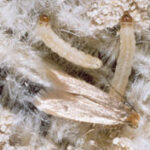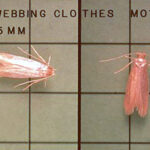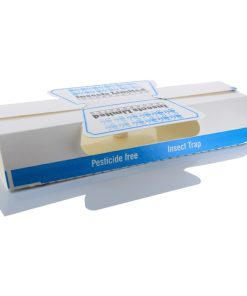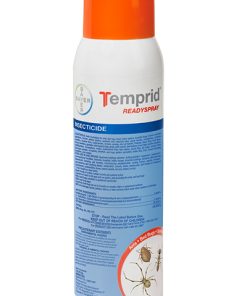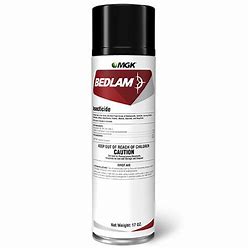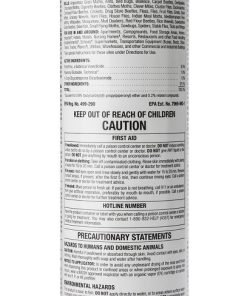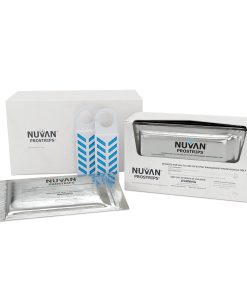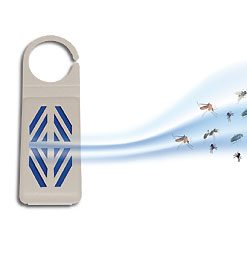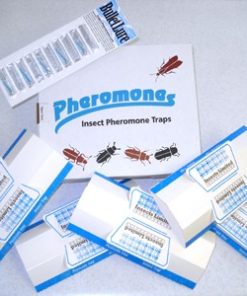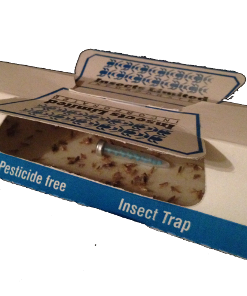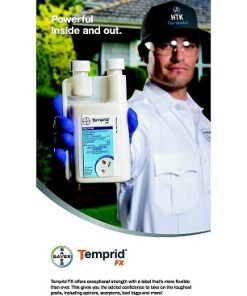Controlling clothes moths
The most common clothes moth that people encounter is the Webbing Clothes Moth. This moth is about 3/8-inch long, and has a cream color, with a tuft of red hair on the top of the head. The larvae are white. Larvae will be found on fabrics among thin sheets of webbing that they spin to shield themselves. They often leave strands of silk on fabrics they infest.
Clothes moth larvae feed on wool, feathers, fur, hair, leather, lint, dust, paper, and occasionally cotton, linen, silk, and synthetic fibers. They are especially damaging to fabric stained with beverages, urine, oil from hair, and sweat. Most damage is done to articles left undisturbed for a long time, such as old blankets, wool upholstery, feathered hats, antique dolls and toys, natural bristle brushes, weaving’s, wall hangings, piano felts, old furs, and especially wool carpets under heavy furniture and clothing in storage. Damaged fabrics have holes eaten through them by small, white larvae and often have silken cases, lines of silken threads, and fecal pellets over the surface of the materials. Moths are destructive during the larvae stage.
Clothes moths rarely fly to lights at night and instead prefer darkness, such as a closet or storage chest. Any clothes moths fluttering around the house are probably males, because females travel by either running, hopping, or trying to hide in the folds of clothing. Female webbing clothes moths lay 40 to 50 eggs that hatch in 4 to 21 days. Larvae like to feed on soiled material, spinning silken mats or tunnels and incorporating textile fragments and bits of fecal pellets. Larvae will wander some distance away from their food source to pupate in crevices. The pupa case is silken with bits of fiber and excrement attached to the outside. The life cycle is about 65 to 90 days.
Clothes moth development is greatly influenced by humidity. About 75-percent relative humidity in a heated, dark room is ideal. If your infested closet has a humidifier, or is next to heavily used bathroom, make sure that the area is properly ventilated.
Aerosols & Ready to Use Products
These “ready to use” products are convenient and great for a contact kill and great for flushing out insects. Most offer great residual properties as well.
Adhesive Traps - Insect
Insect Traps
Aerosols & Ready To Use Products
Aerosols & Ready To Use Products
Aerosols & Ready To Use Products
Aerosols & Ready To Use Products
Insect Traps
565 Label Instructions- Locate source of infestation. Treat nearby cracks and crevices and perform a space treatment of the infested area at a rate of 10 – 20 sec per 1,000 cu ft. To protect woolens and other keratin containing materials, brush clean, then air out. Before treating entire article, treat a small hidden area of fabric to determine if staining will occur. Treat thoroughly by holding dispenser at least 18″ from garment. Treated articles should be put into a darkened closet or other darkened storage such as cedar chests, storage drawers or sealable plastic fabric bags. For best protection clean and treat inside of closets or storage areas by treating 1 sec per 10 sq ft before putting treated materials away. Preventative treatment should be repeated every 6 months. To control a present infestation, treatment may be repeated every 3 days if necessary. Dry clean treated clothes before wearing.
Insecticide Concentrates
– These concentrates are mixed with water and used in a compressed hand held sprayer to make your application.
Spray Concentrates
Spray Concentrates
Spray Concentrates
Treating for Clothes Moths
Locate the source of infestation before treatment. Examine closets and stored goods for larvae cases, moths, and damage. Larvae prefer to feed in secluded, dark places. Use a flashlight and nail file to check for woolen lint and hair under baseboards, in and under seldom moved upholstered furniture, in air ducts, in carpets at the corners of the room and along edges, in stored clothing, and in other places not readily accessible. Check furs or feathers, such as stuffed birds or animal heads, antique feather beds, or felt in pianos, woolen scrap piles, etc. Adult moths do not feed in fabrics, but may be seen in darkened corners at night. Infested items should be thrown out, laundered or dry cleaned.
Vacuum all cracks and crevices in closets and other rooms infested. If carpets and rugs are vacuumed frequently and thoroughly, eggs and larvae will be removed before damage can occur. Vacuum upholstered furniture carefully. If you have pets, pay special attention to removing animal hair—it is a food source for moth larvae.
After vacuuming cracks and crevices in closets and other rooms infested, a Clothes Moth Pheromone Trap(s) can be placed in areas that contain items the larvae feed on, such as wool, hair, feathers, or fur. In small areas, one or two traps can be used. For larger areas such as warehouses and retail stores, place the traps every 25 – 50 feet apart on a grid pattern. The recommended height is eye level.
Recent field research has discovered that 70% more Webbing cloths moths (Tineola bisselliella) are captured in flatter traps vs. the traditional hanging traps. These traps can be placed into drawers, under or behind couches and cabinets or behind doors or on shelves in the darkened areas that these moths prefer. The lower profile also provides less risk of getting clothes stuck in the glue and it is more versatile. Notice the bottom of the Stealth trap. It has a designated area for record-keeping to assist in monitoring.
Bedlam Insecticide is a ready to use aerosol that is specially designed to control clothes moths, bed bugs, lice and dist mites. Apply as a spot treatment to cracks and crevices on and around baseboards, floorboards, furniture and around the edges of carpet. Apply as a surface spray to carpet, rugs, closets, baseboards, furniture, on floor and floor coverings. When treating carpets, floor coverings or rugs spray a sufficient amount to get the spray down into the base where the larval stages are feeding. Spray upper and lower surfaces of rugs or floor covering when possible.
Aerosols & Ready To Use Products
Temprid Ready Spray is also labeled for clothes moths, and can be applied in the cracks and crevices, and under baseboards in areas where these pests are found.
Infested rugs, carpets, and the undersides of cloth furniture should be cleaned thoroughly and can then be treated with a residual insecticide such as Suspend or Tempo.
NUVAN PROSTRIPS give continuous protection against moths, silverfish, cockroaches and other insects as listed in closets, wardrobes and cupboards for up to four (4) months and leaves no smell (odor). Remove strip from sealed bag and hang or stand on wardrobe or closet rail, ensuring that strip does not contact clothes or fabrics and that air can circulate around the strip. Use one 16 g strip to treat 100 to 200 cu. ft. for up to four (4) months. If more than one is required, distribute them within the space equally. Keep the space closed. Record the date of installation so that the old strip may be replaced with a new, fresh, full-strength strip at the end of the four (4) month period or when effectiveness diminishes.
Do not use more than the number of strips recommended for the space to be treated. Do not use where unwrapped food is stored or allow the strip to come into contact with food or cooking utensils. Do not allow children or pets to play or sleep in these areas when treatment is in progress.
Sensitive items, such as museum pieces, wall mountings, furs, taxidermy mounts, etc., might require vault fumigation or treatment with temperature control or Nuvan Prostrips. Smaller items can be placed in your freezer for 3 days, to kill any existing eggs/larvae/pupae.

